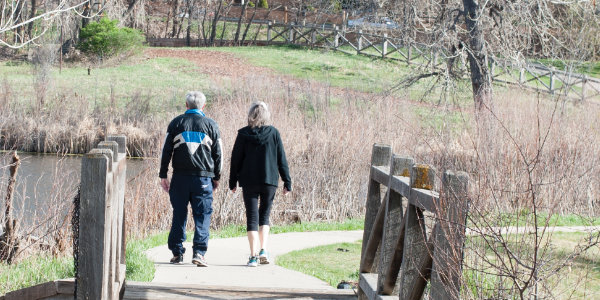Friday April 19, 2024
Savvy Living

How to Improve Your Balance
After taking a fall last month, my doctor suggested I start doing balance exercises. Do you have any tips for balance?
Most people do not think about practicing their balance, but it is a good idea to start doing so. The same way that you walk to strengthen your heart, lungs and overall health, you should practice maintaining your balance.
As we age, our ability to maintain balance declines, which can increase your risk of falling. More than one in three individuals aged 65 or older falls each year and the risk only increases with age. A simple fall can cause a serious fracture of the hip, pelvis, spine, arm, hand or ankle, which can lead to hospitalization, disability, loss of independence and potential fatalities.
Balance is the physical ability to distribute your weight in a way that enables you to hold a steady position or move at will without falling. Balance is controlled by a complex combination of muscle strength, visual inputs, inner ear workings and specialized receptors in the nerves of your joints, muscles, ligaments and tendons which help with orientation. These factors are sorted out in the sensory cortex of your brain, which takes this information and gives you balance. Over time, these neurological pathways dull and causes individuals to gradually lose their balance.
Poor balance can lead to a vicious cycle of inactivity. Individuals who feel unsteady end up curtailing certain activities, which can lead to inactivity. If they are continuously inactive, they no longer challenge their balance systems or their muscles. As a result, both balance and strength decline and simple acts like strolling through a grocery store or getting up from a chair become trickier for these individuals. This can shake their confidence and cause them to become even less active.
If you have a balance problem that is not tied to illness, medication or some other cause, simple exercises may help preserve and improve your balance. Some basic exercises you can do include:
• One-legged stands: Stand on one foot for 30 seconds or longer, then switch to the other foot. You can do this while brushing your teeth or even while waiting in line somewhere. In the beginning, you might want to have a wall or chair to hold on to in case you lose your balance.
• Heel rises: While standing, rise up on your toes, lifting your heel as high as you can. Drop back to the starting position and repeat the process 10 to 20 times. You can make this more difficult by holding light hand weights.
• Heel-toe walk: Take 20 steps and with every step, touch your heel to your toe on your opposite foot. Keep your focus straight ahead instead of looking down at your feet.
• Sit-to-stand: Without using your hands, get up from a straight-backed chair and sit back down 10 to 20 times. This improves balance and leg strength.
For additional balance exercises visit go4life.nia.nih.gov, a resource created by the National Institute on Aging that offers free booklets that provide illustrated examples of many appropriate exercises. You can order your free copy online or by calling 800-222-2225.
Savvy Living is written by Jim Miller, a regular contributor to the NBC Today Show and author of "The Savvy Living" book. Any links in this article are offered as a service and there is no endorsement of any product. These articles are offered as a helpful and informative service to our friends and may not always reflect this organization's official position on some topics. Jim invites you to send your senior questions to: Savvy Living, P.O. Box 5443, Norman, OK 73070.
Most people do not think about practicing their balance, but it is a good idea to start doing so. The same way that you walk to strengthen your heart, lungs and overall health, you should practice maintaining your balance.
As we age, our ability to maintain balance declines, which can increase your risk of falling. More than one in three individuals aged 65 or older falls each year and the risk only increases with age. A simple fall can cause a serious fracture of the hip, pelvis, spine, arm, hand or ankle, which can lead to hospitalization, disability, loss of independence and potential fatalities.
How Balance Works
Balance is the physical ability to distribute your weight in a way that enables you to hold a steady position or move at will without falling. Balance is controlled by a complex combination of muscle strength, visual inputs, inner ear workings and specialized receptors in the nerves of your joints, muscles, ligaments and tendons which help with orientation. These factors are sorted out in the sensory cortex of your brain, which takes this information and gives you balance. Over time, these neurological pathways dull and causes individuals to gradually lose their balance.
Poor balance can lead to a vicious cycle of inactivity. Individuals who feel unsteady end up curtailing certain activities, which can lead to inactivity. If they are continuously inactive, they no longer challenge their balance systems or their muscles. As a result, both balance and strength decline and simple acts like strolling through a grocery store or getting up from a chair become trickier for these individuals. This can shake their confidence and cause them to become even less active.
Balance Exercises
If you have a balance problem that is not tied to illness, medication or some other cause, simple exercises may help preserve and improve your balance. Some basic exercises you can do include:
• One-legged stands: Stand on one foot for 30 seconds or longer, then switch to the other foot. You can do this while brushing your teeth or even while waiting in line somewhere. In the beginning, you might want to have a wall or chair to hold on to in case you lose your balance.
• Heel rises: While standing, rise up on your toes, lifting your heel as high as you can. Drop back to the starting position and repeat the process 10 to 20 times. You can make this more difficult by holding light hand weights.
• Heel-toe walk: Take 20 steps and with every step, touch your heel to your toe on your opposite foot. Keep your focus straight ahead instead of looking down at your feet.
• Sit-to-stand: Without using your hands, get up from a straight-backed chair and sit back down 10 to 20 times. This improves balance and leg strength.
For additional balance exercises visit go4life.nia.nih.gov, a resource created by the National Institute on Aging that offers free booklets that provide illustrated examples of many appropriate exercises. You can order your free copy online or by calling 800-222-2225.
Savvy Living is written by Jim Miller, a regular contributor to the NBC Today Show and author of "The Savvy Living" book. Any links in this article are offered as a service and there is no endorsement of any product. These articles are offered as a helpful and informative service to our friends and may not always reflect this organization's official position on some topics. Jim invites you to send your senior questions to: Savvy Living, P.O. Box 5443, Norman, OK 73070.
Published September 30, 2022
Previous Articles
How to Find Travel Companions for Older Travelers
Will the Inflation Reduction Act Lower Your Drug Costs?





